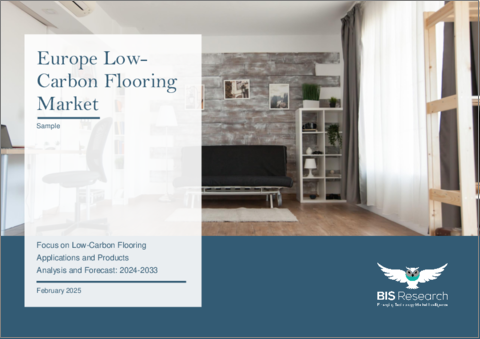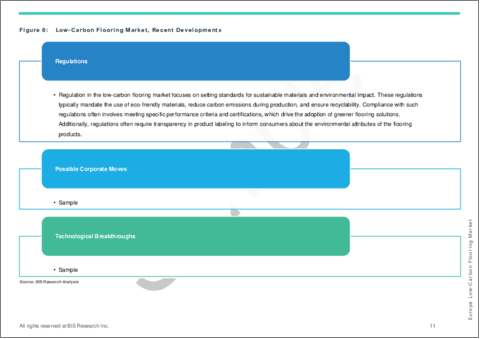|
|
市場調査レポート
商品コード
1668776
欧州の低炭素フローリング市場:低炭素フローリングの用途別、製品別 - 分析と予測(2024年~2033年)Europe Low-Carbon Flooring Market: Focus on Low-Carbon Flooring Applications and Products - Analysis and Forecast, 2024-2033 |
||||||
カスタマイズ可能
|
|||||||
| 欧州の低炭素フローリング市場:低炭素フローリングの用途別、製品別 - 分析と予測(2024年~2033年) |
|
出版日: 2025年03月05日
発行: BIS Research
ページ情報: 英文 80 Pages
納期: 1~5営業日
|
- 全表示
- 概要
- 図表
- 目次
欧州の低炭素フローリングの市場規模は2024年に207億8,000万米ドルとなりました。
同市場は、8.50%のCAGRで拡大し、2033年には432億8,000万米ドルに達すると予測されています。欧州の低炭素フローリング市場は、環境意識の高まりと持続可能な建材を推進する政府の厳しい規制により急速に拡大しています。企業や消費者は、二酸化炭素削減目標や企業の持続可能性イニシアティブに沿うため、環境に優しい床材を選ぶ傾向が強まっています。技術の進歩により手頃な価格と入手しやすさが向上し、普及が加速しています。
| 主要市場統計 | |
|---|---|
| 予測期間 | 2024年~2033年 |
| 2024年の評価額 | 207億8,000万米ドル |
| 2033年予測 | 432億8,000万米ドル |
| CAGR | 8.5% |
欧州の低炭素フローリング市場は、同地域の厳格な環境法と持続可能性への献身的な取り組みにより大きく拡大しています。建築業界における二酸化炭素排出量の削減を目的とした政府規制の結果、環境に優しい床材へのニーズが高まっています。持続可能な建築ソリューションは、企業の持続可能性目標を達成し、全体的な二酸化炭素排出量を削減するために、消費者や企業にとってますます重要になってきています。
低炭素フローリングは、技術の進歩により、より利用しやすく、手頃な価格になっており、住宅と商業施設の両方のプロジェクトに適した選択肢となっています。開発業者や不動産所有者が持続可能性基準を満たすことを目指す中、LEEDやBREEAMのようなグリーンビルディング認証は、これらの材料の使用をさらに促進しています。
また、屋内の空気の質に関する意識の高まりや、無害で低排出の床材がもたらす健康上のメリットも、市場の追い風となっています。欧州全域でグリーン建設プロジェクトへの投資が拡大していることから、業界の主要企業は、高性能で長持ちし、美観に優れた低炭素フローリング製品を生み出すための技術革新に注力しています。
持続可能性が建築動向に影響を与え続けていることから、低炭素フローリング市場の成長が見込まれています。このことは、より環境に優しい建築環境への移行を支援したいと考える生産者、サプライヤー、投資家にとって大きな展望をもたらします。
当レポートでは、欧州の低炭素フローリング市場について調査し、市場の概要とともに、用途別、製品別、地域別の動向、および市場に参入する企業のプロファイルなどを提供しています。
目次
エグゼクティブサマリー
第1章 市場
- 動向:現在および将来の影響評価
- サプライチェーンの概要
- 研究開発レビュー
- 規制状況
- ステークホルダー分析
- 市場力学の概要
第2章 地域
- 地域別概要
- 促進要因と抑制要因
- 欧州
第3章 市場-競合ベンチマーキングと企業プロファイル
- 今後の見通し
- 地理的評価
- Tarkett
- Forbo Group
- Kingspan Group
- Gerflor
- Amtico International
- Parterre Flooring and Surface Systems, LLC
- Beaulieu International Group
- Emilceramica S.r.l.
- CLASSEN Group
- その他
第4章 調査手法
List of Figures
- Figure 1: Low-Carbon Flooring Market (by Region), 2023, 2026, and 2033
- Figure 2: Europe Low-Carbon Flooring Market (by End-Use Industry), 2023, 2026, and 2033
- Figure 3: Europe Low-Carbon Flooring Market (by Material Type), 2023, 2026, and 2033
- Figure 4: Europe Low-Carbon Flooring Market (by Design Type), 2023, 2026, and 2033
- Figure 5: Europe Low-Carbon Flooring Market (by Type), 2023, 2026, and 2033
- Figure 6: Low-Carbon Flooring Market, Recent Developments
- Figure 7: Supply Chain and Risks within the Supply Chain
- Figure 8: Low-Carbon Flooring Market, Pricing Forecast, ($USD/per square foot), 2023.2027, and 2033
- Figure 9: Low-Carbon Flooring Market (by Country), January 2021-December 2023
- Figure 10: Low-Carbon Flooring Market (by Company), January 2021-December 2023
- Figure 11: Impact Analysis of Market Navigating Factors, 2024-2033
- Figure 12: Germany Low-Carbon Flooring Market, $Million, 2023-2033
- Figure 13: France Low-Carbon Flooring Market, $Million, 2023-2033
- Figure 14: U.K. Low-Carbon Flooring Market, $Million, 2023-2033
- Figure 15: Italy Low-Carbon Flooring Market, $Million, 2023-2033
- Figure 16: Rest-of-Europe Low-Carbon Flooring Market, $Million, 2023-2033
- Figure 17: Strategic Initiatives, 2021-2024
- Figure 18: Share of Strategic Initiatives, 2021-2024
- Figure 19: Data Triangulation
- Figure 20: Top-Down and Bottom-Up Approach
- Figure 21: Assumptions and Limitations
List of Tables
- Table 1: Market Snapshot
- Table 2: Opportunities across Regions
- Table 3: Low-Carbon Flooring Market (by Region), $Million, 2023-2033
- Table 4: Europe Low-Carbon Flooring Market (by End-Use Industry), $Million, 2023-2033
- Table 5: Europe Low-Carbon Flooring Market (by Material Type), $Million, 2023-2033
- Table 6: Europe Low-Carbon Flooring Market (by Design Type), $Million, 2023-2033
- Table 7: Europe Low-Carbon Flooring Market (by Type), $Million, 2023-2033
- Table 8: Germany Low-Carbon Flooring Market (by End-Use Industry), $Million, 2023-2033
- Table 9: Germany Low-Carbon Flooring Market (by Material Type), $Million, 2023-2033
- Table 10: Germany Low-Carbon Flooring Market (by Design Type), $Million, 2023-2033
- Table 11: Germany Low-Carbon Flooring Market (by Type), $Million, 2023-2033
- Table 12: France Low-Carbon Flooring Market (by End-Use Industry), $Million, 2023-2033
- Table 13: France Low-Carbon Flooring Market (by Material Type), $Million, 2023-2033
- Table 14: France Low-Carbon Flooring Market (by Design Type), $Million, 2023-2033
- Table 15: France Low-Carbon Flooring Market (by Type), $Million, 2023-2033
- Table 16: U.K. Low-Carbon Flooring Market (by End-Use Industry), $Million, 2023-2033
- Table 17: U.K. Low-Carbon Flooring Market (by Material Type), $Million, 2023-2033
- Table 18: U.K. Low-Carbon Flooring Market (by Design Type), $Million, 2023-2033
- Table 19: U.K. Low-Carbon Flooring Market (by Type), $Million, 2023-2033
- Table 20: Italy Low-Carbon Flooring Market (by End-Use Industry), $Million, 2023-2033
- Table 21: Italy Low-Carbon Flooring Market (by Material Type), $Million, 2023-2033
- Table 22: Italy Low-Carbon Flooring Market (by Design Type), $Million, 2023-2033
- Table 23: Italy Low-Carbon Flooring Market (by Type), $Million, 2023-2033
- Table 24: Rest-of-Europe Low-Carbon Flooring Market (by End-Use Industry), $Million, 2023-2033
- Table 25: Rest-of-Europe Low-Carbon Flooring Market (by Material Type), $Million, 2023-2033
- Table 26: Rest-of-Europe Low-Carbon Flooring Market (by Design Type), $Million, 2023-2033
- Table 27: Rest-of-Europe Low-Carbon Flooring Market (by Type), $Million, 2023-2033
- Table 28: Market Share, 2023
Introduction to Europe Low-Carbon Flooring Market
The Europe low-carbon flooring market was valued at $20.78 billion in 2024, and it is expected to grow at a CAGR of 8.50% and reach $43.28 billion by 2033. The Europe Low-Carbon Flooring Market is rapidly expanding due to increased environmental awareness and strict government regulations promoting sustainable building materials. Businesses and consumers are increasingly opting for eco-friendly flooring to align with carbon reduction targets and corporate sustainability initiatives. Technological advancements have enhanced affordability and accessibility, accelerating adoption.
Market Introduction
| KEY MARKET STATISTICS | |
|---|---|
| Forecast Period | 2024 - 2033 |
| 2024 Evaluation | $20.78 Billion |
| 2033 Forecast | $43.28 Billion |
| CAGR | 8.5% |
The European market for low-carbon flooring is expanding significantly due to the region's strict environmental laws and dedication to sustainability. The need for environmentally friendly flooring materials has increased as a result of government regulations aimed at lowering carbon emissions in the building industry. Sustainable building solutions are becoming more and more important to consumers and businesses in order to meet corporate sustainability objectives and lower their overall carbon footprint.
Low-carbon flooring options are now much more accessible and affordable thanks to technological advancements, making them a good option for both residential and commercial projects. As developers and property owners look to meet sustainability standards, green building certifications like LEED and BREEAM are further promoting the use of these materials.
The market is also benefiting from increased awareness about indoor air quality and the health benefits of non-toxic, low-emission flooring solutions. Key industry players are concentrating on innovation to create high-performance, long-lasting, and aesthetically pleasing low-carbon flooring products as a result of growing investments in green construction projects throughout Europe.
The market for low-carbon flooring is expected to grow as sustainability continues to influence building trends. This presents substantial prospects for producers, suppliers, and investors who wish to support the shift to a more environmentally friendly built environment.
Market Segmentation
Segmentation 1: by End-Use Industry
- Residential
- Non-Residential
Segmentation 2: by Material Type
- Linoleum
- Wood
- Cork
- Bamboo
- Stone
- Others
Segmentation 3: by Design Type
- Sheets
- Carpet
- Blocks and Tiles
Segmentation 4: by Type
- Virgin Products
- Recycled Solutions
Segmentation 5: by Region
- Europe: Germany, France, U.K., Italy, and Rest-of-Europe
How can this report add value to an organization?
Product/Innovation Strategy: The product segment helps the reader understand the different applications and products of Europe low-carbon flooring market. The market is poised for significant expansion with ongoing technological advancements, increased investments, and growing awareness of the importance of low-carbon flooring. Therefore, the low-carbon flooring business is a high-investment and high-revenue generating model.
Growth/Marketing Strategy: The Europe low-carbon flooring market has been growing at a rapid pace. The market offers enormous opportunities for existing and emerging market players. Some of the strategies covered in this segment are mergers and acquisitions, product launches, partnerships and collaborations, business expansions, and investments. The strategies preferred by companies to maintain and strengthen their market position primarily include product development.
Competitive Strategy: The key players in the Europe low-carbon flooring market analyzed and profiled in the study include professionals with expertise in the flooring industry. Additionally, a comprehensive competitive landscape such as partnerships, agreements, and collaborations are expected to aid the reader in understanding the untapped revenue pockets in the market.
Key Market Players and Competition Synopsis
The companies that are profiled in the report have been selected based on inputs gathered from primary experts and analyzing company coverage, product portfolio, and market penetration.
Some of the prominent names in this market are:
- Tarkett
- Forbo Group
- Kingspan Group
- Gerflor
- Amtico International
- Parterre Flooring and Surface Systems, LLC
- Emilceramica S.r.l.
Table of Contents
Executive Summary
Scope and Definition
1 Markets
- 1.1 Trends: Current and Future Impact Assessment
- 1.1.1 Trend: Overview
- 1.1.2 Construction Industry Overview
- 1.1.3 Embodied Carbon Reduction Efforts
- 1.2 Supply Chain Overview
- 1.2.1 Value Chain Analysis
- 1.2.2 Pricing Forecast
- 1.3 Research and Development Review
- 1.3.1 Patent Filing Trend (by Country, Company)
- 1.4 Regulatory Landscape
- 1.4.1 Country-Specific Flooring Standards
- 1.4.2 ASTM Standards and Specifications
- 1.4.3 Impact of UN SDG Adoptions on the Construction Industry
- 1.5 Stakeholder Analysis
- 1.5.1 Case Study
- 1.5.1.1 Elevating Summit House with Classic Oak Flooring
- 1.5.1.2 Transforming Headquarters with High-Performance Tiles
- 1.5.2 End User and Buying Criteria
- 1.5.1 Case Study
- 1.6 Market Dynamics Overview
- 1.6.1 Market Drivers
- 1.6.1.1 Consumer Demand for Sustainable Products
- 1.6.1.2 Corporate Sustainability Initiatives
- 1.6.2 Market Restraints
- 1.6.2.1 Supply Chain Challenges
- 1.6.3 Market Opportunities
- 1.6.3.1 Innovation in Materials and Designs
- 1.6.3.2 Integration with Smart Home Technologies
- 1.6.1 Market Drivers
2 Regions
- 2.1 Regional Summary
- 2.2 Drivers and Restraints
- 2.3 Europe
- 2.3.1 Regional Overview
- 2.3.2 Driving Factors for Market Growth
- 2.3.3 Factors Challenging the Market
- 2.3.4 Application
- 2.3.5 Product
- 2.3.6 Germany
- 2.3.7 France
- 2.3.8 U.K.
- 2.3.9 Italy
- 2.3.10 Rest-of-Europe
3 Markets - Competitive Benchmarking & Company Profiles
- 3.1 Next Frontiers
- 3.2 Geographic Assessment
- 3.2.1 Tarkett
- 3.2.1.1 Overview
- 3.2.1.2 Top Products/Product Portfolio
- 3.2.1.3 Top Competitors
- 3.2.1.4 Target Customers
- 3.2.1.5 Key Personnel
- 3.2.1.6 Analyst View
- 3.2.1.7 Market Share, 2023
- 3.2.2 Forbo Group
- 3.2.2.1 Overview
- 3.2.2.2 Top Products/Product Portfolio
- 3.2.2.3 Top Competitors
- 3.2.2.4 Target Customers
- 3.2.2.5 Key Personnel
- 3.2.2.6 Analyst View
- 3.2.2.7 Market Share, 2023
- 3.2.3 Kingspan Group
- 3.2.3.1 Overview
- 3.2.3.2 Top Products/Product Portfolio
- 3.2.3.3 Top Competitors
- 3.2.3.4 Target Customers
- 3.2.3.5 Key Personnel
- 3.2.3.6 Analyst View
- 3.2.3.7 Market Share, 2023
- 3.2.4 Gerflor
- 3.2.4.1 Overview
- 3.2.4.2 Top Products/Product Portfolio
- 3.2.4.3 Top Competitors
- 3.2.4.4 Target Customers
- 3.2.4.5 Key Personnel
- 3.2.4.6 Analyst View
- 3.2.4.7 Market Share, 2023
- 3.2.5 Amtico International
- 3.2.5.1 Overview
- 3.2.5.2 Top Products/Product Portfolio
- 3.2.5.3 Top Competitors
- 3.2.5.4 Target Customers
- 3.2.5.5 Key Personnel
- 3.2.5.6 Analyst View
- 3.2.5.7 Market Share, 2023
- 3.2.6 Parterre Flooring and Surface Systems, LLC
- 3.2.6.1 Overview
- 3.2.6.2 Top Products/Product Portfolio
- 3.2.6.3 Top Competitors
- 3.2.6.4 Target Customers
- 3.2.6.5 Key Personnel
- 3.2.6.6 Analyst View
- 3.2.7 Beaulieu International Group
- 3.2.7.1 Overview
- 3.2.7.2 Top Products/Product Portfolio
- 3.2.7.3 Top Competitors
- 3.2.7.4 Target Customers
- 3.2.7.5 Key Personnel
- 3.2.7.6 Analyst View
- 3.2.7.7 Market Share, 2023
- 3.2.8 Emilceramica S.r.l.
- 3.2.8.1 Overview
- 3.2.8.2 Top Products/Product Portfolio
- 3.2.8.3 Top Competitors
- 3.2.8.4 Target Customers
- 3.2.8.5 Key Personnel
- 3.2.8.6 Analyst View
- 3.2.9 CLASSEN Group
- 3.2.9.1 Overview
- 3.2.9.2 Top Products/Product Portfolio
- 3.2.9.3 Top Competitors
- 3.2.9.4 Target Customers
- 3.2.9.5 Key Personnel
- 3.2.9.6 Analyst View
- 3.2.10 Other Players
- 3.2.1 Tarkett
4 Research Methodology
- 4.1 Data Sources
- 4.1.1 Primary Data Sources
- 4.1.2 Secondary Data Sources
- 4.1.3 Data Triangulation
- 4.2 Market Estimation and Forecast






